
A biome is a large collection of flora and fauna occupying a major habitat.
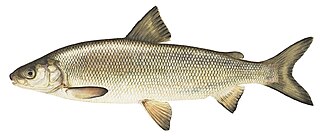
Coregonus is a diverse genus of fish in the salmon family (Salmonidae). The Coregonus species are known as whitefishes. The genus contains at least 68 described extant taxa, but the true number of species is a matter of debate. The type species of the genus is Coregonus lavaretus.

The Congo River, formerly also known as the Zaire River, is the second longest river in Africa, shorter only than the Nile, as well as the second largest river in the world by discharge volume, following only the Amazon. It is also the world's deepest recorded river, with measured depths in excess of 220 m (720 ft). The Congo-Lualaba-Chambeshi River system has an overall length of 4,700 km (2,920 mi), which makes it the world's ninth-longest river. The Chambeshi is a tributary of the Lualaba River, and Lualaba is the name of the Congo River upstream of Boyoma Falls, extending for 1,800 km (1,120 mi).

An ecoregion or ecozone is an ecologically and geographically defined area that is smaller than a bioregion, which in turn is smaller than a biogeographic realm. Ecoregions cover relatively large areas of land or water, and contain characteristic, geographically distinct assemblages of natural communities and species. The biodiversity of flora, fauna and ecosystems that characterise an ecoregion tends to be distinct from that of other ecoregions. In theory, biodiversity or conservation ecoregions are relatively large areas of land or water where the probability of encountering different species and communities at any given point remains relatively constant, within an acceptable range of variation.

The Chao Phraya is the major river in Thailand, with its low alluvial plain forming the centre of the country. It flows through Bangkok and then into the Gulf of Thailand.

The bull shark, also known as the "Zambezi shark" in Africa, and "Lake Nicaragua shark" in Nicaragua, is a requiem shark commonly found worldwide in warm, shallow waters along coasts and in rivers. It is known for its aggressive nature, and presence in warm, shallow brackish and freshwater systems including estuaries and rivers.

Chukotka, officially the Chukotka Autonomous Okrug, is the easternmost federal subject of Russia. It is an autonomous okrug situated in the Russian Far East, and shares a border with the Sakha Republic to the west, Magadan Oblast to the south-west, and Kamchatka Krai to the south. Anadyr is the largest town and the capital, and the easternmost settlement to have town status in Russia.
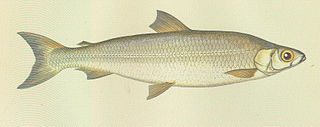
The pollan or Irish pollan is a freshwater whitefish known only from five Irish lakes, Lough Neagh, Lower Lough Erne, Lough Ree, Lough Derg, and Lough Allen. The Irish pollan faces competition from introduced species such as pike, roach, and zebra mussel and the populations rely on restocking for survival.
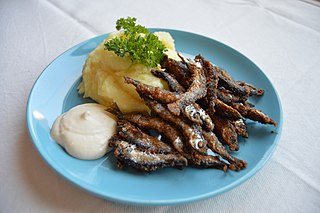
Coregonus albula, known as the vendace or as the European cisco, is a species of freshwater whitefish in the family Salmonidae. It is found in lakes in northern Europe, especially Finland, Latvia, Lithuania, Sweden, Russia and Estonia, and in some lakes of Norway, the United Kingdom, northern Germany, and Poland. It is also found in diluted brackish water in the Gulfs of Finland and Bothnia, both of which are in the Baltic Sea.

The broad whitefish is a freshwater whitefish species. Dark silvery in colour, and like a herring in its shape, its distinctive features include a convex head, short gill rakers, and a mild overbite. It is found in the Arctic-draining streams, lakes, and rivers of far eastern Russia and North America. Its prey includes larval insects, snails, and shellfish. It is eaten by humans and brown bears.
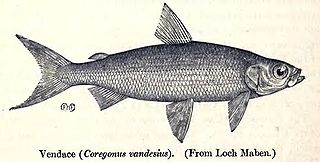
Coregonus vandesius, the vendace, is a freshwater whitefish found in the United Kingdom. Population surveys since the 1960s have revealed a steady decline and the fish is no longer present in some of its previous haunts but is still present in Bassenthwaite Lake and Derwent Water. The main threats it faces are eutrophication and the introduction of alien species of fish which eat its eggs and fry. The International Union for Conservation of Nature has rated its conservation status as "endangered".

The Atlantic whitefish is a coregonine fish inhabiting some freshwater lakes within Nova Scotia, Canada. It is known to survive only in the Petite Rivière watershed as landlocked populations. Earlier it was also found in the Tusket and Annis rivers of Nova Scotia. Those populations were anadromous, migrating to the estuary to feed while breeding in freshwater.
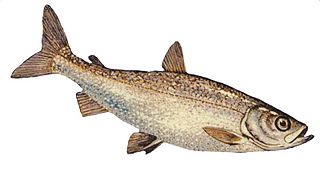
The freshwater whitefish are fishes of the subfamily Coregoninae, which contains whitefishes and ciscoes, and is one of three subfamilies in the salmon family Salmonidae. Apart from the subfamily Coregoninae, the family Salmonidae includes the salmon, trout, and char species of the subfamily Salmoninae, and grayling species of the subfamily Thymallinae. Freshwater whitefish are distributed mainly in relatively cool waters throughout the northern parts of the Northern Hemisphere.

The houting is a European, allegedly extinct species of whitefish in the family Salmonidae. It is native to the estuaries and rivers draining to the North Sea. The houting is distinguishable from other Coregonus taxa by having a long, pointed snout, an inferior mouth and a different number of gill rakers. The houting once occurred in Belgium, France, Germany, the Netherlands and England.

The humpback whitefish, also referred to as the bottom whitefish, the Arctic whitefish or the pidschian, is a species of freshwater whitefish with a northern distribution. It is one of the members in the broader common whitefish complex, or the Coregonus clupeaformis complex. This fish lives in estuaries and brackish water near river mouths, in deltas and in slowly running rivers, in large lakes with tributaries, and floodplain lakes. It can migrate long distances upriver for spawning.
Coregonus fontanae, also known as the Stechlin cisco, Fontane cisco, or Fontane's cisco, is a species of freshwater whitefish in the family Salmonidae endemic to the Großer Stechlinsee in northern Germany. It is believed to have recently evolved from the sympatric vendace, Coregonus albula.

The Bering cisco or Lauretta whitefish is a freshwater whitefish found in Alaska and part of Russia. It is often considered to be the same species as the more common Arctic cisco.

The granular pugolovka is a species of gobiid fish widespread in the Caspian Sea. It is a small fish, with a length up to 5.6 centimetres (2.2 in) TL. It was listed as Least Concern by the IUCN in 2008: there are no known major threats. Granular pugolovkas are very abundant in their habitat due to their size and lack of natural predators. The common name 'pugolovka' is a Ukrainian word for tadpole.

Squalius janae, commonly known as the Istrian chub, is a species of freshwater fish in the carp family Cyprinidae. It was first described in 2010 from the Dragonja River drainage in Slovenia. Since then they have also been found in the Boljunčica and Pazinčica river drainages in Istria, Croatia.

The Amur whitefish is a species of freshwater whitefish. It can withstand significant salinity levels. It reaches a maximum size of 60 cm (24 in), with a maximum weight of 2 kg (4.4 lb). Its life expectancy is 10 to 11 years. The Amur whitefish is usually eaten salted or smoked.


















